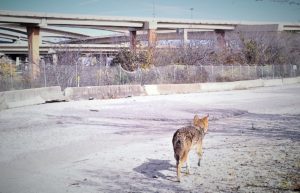When I asked School IPM Coordinators what topics they wanted to learn more about this year, managing wildlife topped the list. For most people, “nuisance wildlife” means an animal is destructive or menacing. The animal may be damaging property such as buildings, crops, pets, livestock, gardens, or public parks. Wildlife may threaten human health or safety by spreading diseases; through direct attacks; or accidentally, because of collisions with cars, airplanes, or trains.
The most common wildlife issues in Texas are bats, skunks, racoons, opossums, coyotes and feral hogs. For this article I have included several handouts that will help you to educate yourself and your staff on the best management practices for managing nuisance wildlife on your school campus.

Coyote in an urban area, image from wilddallas, CC-BY_NC 4.0
A slender, dog-like carnivore, coyotes are common throughout Texas. They have adapted easily to the expansion of human communities into their habitat and can occasionally be found in urban and suburban neighborhoods. Coyotes may live alone or in small “packs” of up to 6 individuals. They hunt at all hours of the day and night but may be seen more often in the early morning or just before sunset.
Urban and suburban coyotes, like urban deer, are symptoms of a broader issue. People continue to expand housing subdivisions and other human development into what used to be open range wildlife habitat, especially on the expanding fringes of large metropolitan areas. This is increasing the potential for encounters and conflicts between people and wildlife.
Trapping and similar nuisance control actions cannot eliminate urban coyote problems, although this can be part of the solution in some situations. The real solution and the greater need facing Texans right now is public education. We must inform the communities we work and live in and empower people to take steps to coexist with coyotes and other urban wildlife.
Managing Coyotes on School Grounds: An Integrated Wildlife Damage Management Approach was written by John Tomecek, Michael Bodenchuk, and Mike Merchant to help schools in Texas with a growing problem. This 6-page publication is perfect way to share educational information with teachers, administrators and parents on what they should do if they see a coyote on school grounds.
Managing Coyotes on School Grounds (download this PDF file)

This Mexican Free-tailed bat image was taken by Stephen Biles, IPM Agent, AgriLife Extension
No matter the time of year, bats in and around schools are always on the minds of IPM Coordinators. Half of the state of Texas remains mild to warm throughout the year, which allows the Mexican free-tail bat to roost in buildings and bridges. Over the years I have written numerous newsletter articles on this topic. We even have our website https://agrilife.org/batsinschools/ and color brochures. However, I know many of you wanted something that you can distribute to others in your district. In February 2017 I wrote a newsletter article on bat management what everyone should know. The trouble with the article was it is not the easiest to print and share. For this newsletter I have created this article as a PDF file
Bat Management what everyone should know is a 3-page document that you can print, post and share with others on how to live with and manage bats on school campuses.
Feral hogs (or Wild Hogs) continue to grow in numbers in Texas and elsewhere. Because of their destructive feeding habits and potential to spread disease, feral hogs are a substantial liability to agriculture and native wildlife in Texas. However, these animals are also sought for recreational hunting and commercial harvest. The AgriLife Extension Wildlife & Fisheries Unit has a website dedicated to this topic which covers feral hog biology, natural history, damage management, and control techniques. If you want to learn more about this problem “pest” the please visit their website for more information. Feral Hogs
Finally here are a few more documents you should check out.
Wildlife Diseases helps you to understand rabies, plague, Giardiasis, Rocky Mountain Spotted Fever, Leptospirosis, Histoplasmosis and few more of the more common diseases that can be transmitted from animal to human.
Mange in Wildlife: Identification and Implications for Human and Animal Health is a 4-page document on how to notice mange on wild animals.
Managing Skunk Damage is a 2-page fact sheet that is designed to help everyone understand why managing skunks is important

 .
.